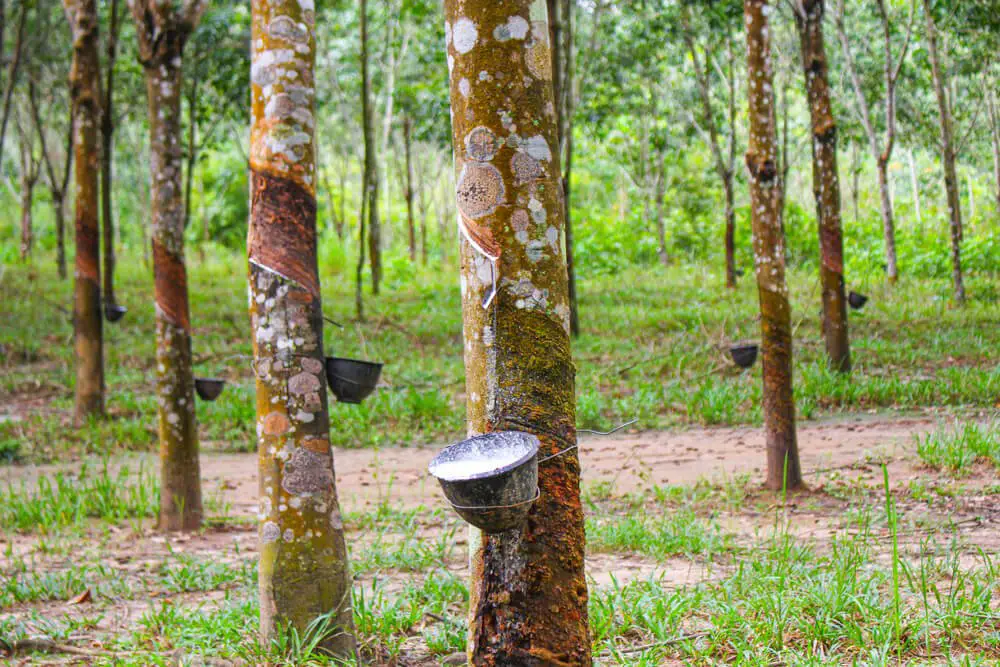Last Updated on July 16, 2023 By Emma W. Thomas
Rubberwood, also known as parawood, is obtained from the rubber tree and it is a sustainable option for furniture as it utilizes trees that have reached the end of their productive life. Rubberwood has a light color, takes stains well, and displays minimal shrinkage, making it suitable for various furniture pieces.
What is Rubberwood?
Rubberwood, also known as Hevea brasiliensis, is a type of tropical hardwood that comes from the rubber tree. It is a versatile and sustainable material widely used in the furniture and woodworking industries. Rubberwood is primarily cultivated for its latex sap, which is used to produce natural rubber. Once the rubber tree reaches the end of its latex production cycle, it is cut down and processed into timber.
The timber derived from rubberwood has gained popularity due to its eco-friendly nature, as it provides an alternative to deforestation. Moreover, rubberwood exhibits appealing characteristics such as durability, resilience, and a light-colored appearance that allows for flexibility in design and finishing. With its favorable attributes and sustainable sourcing, rubberwood has become a preferred choice for furniture manufacturers and eco-conscious consumers alike.
What Qualities Make Rubberwood Suitable For Woodwork Projects?

Woodwork is a perfect choice for many woodwork projects, including furniture making. Some of the qualities include;
- It can be easily sawed and machined to produce a reasonably smooth surface.
- It is easy to control in the kiln during the drying process due to its dense grains
- It has a good strength of lumber which makes it easy to use both machine and hand tools when working with it
- Rubberwood is low-cost, and it holds nails and screws in place.
- It takes in stains properly and can be painted to give your desirable appearance.
List of Common Rubberwood Furniture
- Dining table
- Dining chairs
- Coffee table
- Side table
- Bed frame
- Dresser
- Nightstand
- Bookshelf
- TV stand
- Writing desk
- Cabinet
- Wardrobe
- Shoe rack
- Bench
- Bar stools
What Are The Advantages Of Rubberwood Furniture?
Rubberwood is easy to use when making furniture, especially by hand. The wood is easy to finish, stain, and paint. Its furniture has several advantages, including;
Easy To Care For The Furniture Pieces
Caring for rubberwood furniture is a simple process. You only need to use a solution of mild soap and water to wash the surface and then dry it with a clean, dry piece of cloth. You also need to avoid standing water on your furniture pieces which could damage the applied finish. You can also use paste wax on the furniture to lighten it, but remember to remove the waxes to prevent dust accumulation. This wax could also turn yellow if left for long on the surface.
The wood does not also require ointment and sprays to maintain its natural sheen.
Durability
With proper cure, rubberwood can last long, just like hardwood. This material gives a stable profile for flexible applications such as making tables, chairs, and other items. The furniture pieces can last for between 15 to 25 years when taken good care of.
It Is Sustainable
Using rubberwood for furniture can be a sustainable investment. This product comes from trees whose purpose of latex harvesting has been achieved. Rubberwood is harvested from plantation trees whose rubber production cycle is over, preventing the trees from rotting.
Using the trees for rubberwood creates room for planting more, making it environmentally friendly and a worthy investment.
It Provides Proper Shock Absorption.
Rubberwood has better shock-absorbent characteristics than other wood products. When used in furniture production, rubberwood provides comfort and cushioning. This property makes the furniture pieces suitable for those people with physical challenges and the elderly. The support and comfort help decrease stress and promote better movement.
Cost-effectiveness
Rubberwood is thought of as a by-product, making it cheaper than most wood. Though of good quality, its furniture may sell at a lower price than that from other types of wood.
It Takes Stains Better Than Others.
Rubberwood is very effective for those who want to change the appearance of their furniture. It takes finishes and stains well to suit its setting and taste.
Resistant To Burn, Fire, And Mold
Rubberwood furniture is resistant to burn, such as those from a cigarette butt. This timber also has antimicrobial properties that prevent molds, fungi, and bacteria damage. If the wood catches fire, it will not release dangerous greenhouse gases.
What Are Some Disadvantages Of Using Rubberwood For Furniture Making?

Rubberwood furniture has some disadvantages as well, including;
Its Structure Changes As It Dries Out
Rubberwood has a high moisture content that makes it twist and warp as it dries out, challenging the curing process. This problem makes it impossible to get uncured rubberwood for furniture production, which translates to a high cost of production.
The high moisture content makes rubberwood take a long time to dry out. It can take up to half a year for younger trees to dry entirely and at least one year for the older ones before being used for furniture.
It Is More Susceptible To Damage.
Rubberwood furniture can be easily damaged as compared to other kinds of timber. This product gets discolored when exposed to direct sunlight, which may destroy the surface’s finish over time. The spills from water and alcohol may also damage the furniture finish if allowed to sit on it for an extended period.
The Furniture Pieces May Get Dents Over Time.
Since rubberwood is moderately hard, its furniture can get dents upon any impact. But, these dents can be repaired by adding more finish. The dents could also be fixed by using a little steam and heat. A hot iron, washcloth, and towel may be used to do this. You need to drape the item over the dent and leave it for about one minute. Doing this helps the rubberwood to swell, thus removing the dent.
Not Suitable For People With Latex Allergy
Furniture pieces made from rubberwood are unsuitable for those allergic to natural latex. You can know that you have this allergy when your skin reacts upon using such furniture. If you experience severe reactions, be sure to avoid the table entirely even if it is sealed.
Is Rubberwood Good for Indoor Furniture?
Yes, rubberwood is generally considered good for indoor furniture. It is a popular choice for indoor furniture due to its desirable properties, such as:
- Eco-friendliness: Rubberwood is a sustainable option as it comes from the rubber tree, which is used for latex production and then harvested for furniture once it reaches the end of its latex-producing cycle.
- Versatility: Rubberwood can be easily shaped and crafted into various furniture pieces, making it suitable for a wide range of indoor furniture, including tables, chairs, beds, cabinets, and more.
- Aesthetics: It has a light, natural color that complements various interior styles. Rubberwood also takes stains and finishes well, allowing for customization.
- Reasonable cost: Rubberwood is often more affordable compared to other hardwood options, making it a budget-friendly choice for indoor furniture.
- Durable when properly treated: With the right treatment and finishing, rubberwood can have good durability for indoor use, although it may not be as hard as some other hardwoods.
Is Rubberwood Good for Outdoor Furniture?
Rubberwood is not considered a suitable material for outdoor furniture. While it has some desirable properties for indoor use, such as being eco-friendly and affordable, it lacks the natural resistance to weather and moisture that is essential for outdoor furniture.
Rubberwood is a relatively soft wood, and exposure to outdoor elements like rain, sunlight, and fluctuating temperatures can cause it to deteriorate quickly. It is prone to rot, warping, and cracking when exposed to moisture, making it unsuitable for outdoor use where furniture needs to withstand harsh weather conditions.
For outdoor furniture, it’s best to choose materials that are specifically designed to withstand outdoor environments, such as teak, cedar, redwood, or certain types of metal or synthetic materials. These options offer better durability and weather resistance, ensuring your outdoor furniture remains in good condition for an extended period.
Conclusion
Rubberwood is a hardwood from the maple family suitable for carving wooden accessories and furniture. It is an environment-friendly product that reuses plantation trees whose rubber production has been achieved.
It is strong, flexible, and one of the finest timber for making furniture. It can also help make commercial trays, cabinetry, and carvings, among other items.
Emma is a graduate of Domestic Science or Family and Consumer Sciences (Home Economics) from the University of Wisconsin. She has 7 years of experience Working with the strategic section of BestBuy and now writing full-time for Homeeon.
From Managing the Home, Interiors, Cleaning, and Exteriors to Gardening and everything about Making A Home Liveable – is her passion and this Homeeon is the result of this.
Emma loves decorating her home with the best stuff found online. She cares about quality over anything and writes reviews about them here in Homeeon. Get in touch with her over Pinterest.
Keep reading her blogs.

